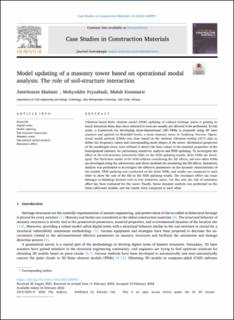Model Updating of a Masonry Tower based on Operational Modal Analysis: The Role of Soil-structure Interaction
Peer reviewed, Journal article
Published version
Permanent lenke
https://hdl.handle.net/11250/2996905Utgivelsesdato
2022-02-18Metadata
Vis full innførselSamlinger
Originalversjon
Case Studies in Construction Materials. 2022, 16 . https://doi.org/10.1016/j.cscm.2022.e00957Sammendrag
Vibration-based finite element model (FEM) updating of cultural heritage assets is gaining so much attraction these days since destructive tests are usually not allowed to be performed. In this study, a framework for developing three-dimensional (3D) FEMs is proposed using 3D laser scanners and applied on Slottsfjell tower, a stone masonry tower in Tønsberg, Norway. Operational modal analysis (OMA) was done based on the ambient vibration testing (AVT) data to define the frequency values and corresponding mode shapes of the tower. Mechanical properties of the tønsbergite stone were utilized to derive the base values of the material properties of the homogenized masonry for performing sensitivity analysis and FEM updating. To investigate the effect of the soil-structure interaction (SSI) on the FEM updating results, three FEMs are developed. The fixed-base model is the FEM without considering the SSI effects, and two other FEMs are developed using the substructure and direct methods for simulating the SSI effects. Sensitivity analysis was performed to investigate the effective parameters on the dynamic characteristics of the models. FEM updating was conducted on the three FEMs, and results are compared to each other to show the role of the SSI on the FEM updating results. The resonance effect can cause
damages to buildings located even in low seismicity zones. For this aim, the risk of resonance effect has been evaluated for the tower. Finally, linear dynamic analysis was performed on the three calibrated models, and the results were compared to each other.

